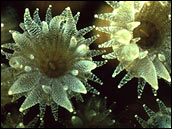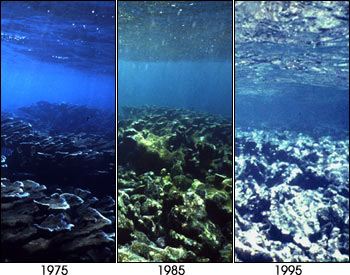| |
Phil Dustan, a marine biologist at the College of Charleston, has been lending
his expertise to the satellite monitoring effort. For the past five years, he has been working as a
principal investigator with the Environmental Protection Agency (EPA) in the Coral Reef Monitoring
Project to study the reefs of the Florida Keys.
|
|
|
| |
Dustan explains that corals in many respects are very thin amounts of tissue on
top of a rock that they build (Dustan 1999). Though they may appear to be jagged stone plants sprouting
from the ocean floor, only a very thin layer of polyps on the coral’s surface is actually alive. These
polyps, which resemble tiny sea anemones, build interconnected tubes around themselves as protection
against predators. Each time new polyps are born, they will construct their shells on top of their
predecessors’ empty encasements. Stacks upon stacks of the limestone shells pile up on top of one
another through the years to create coral branches and heads and ultimately giant reefs (Miller and
Crosby 1998). Over millions of years, thousands of species of sea creatures have come to rely on the
habitat that the reefs provide. So far, researchers have identified nearly 4,000 kinds of fish and tens
of thousands of invertebrates that thrive and depend on some 800 types of known coral. Some scientists
speculate that there may be hundreds of thousands of species of reef-dwelling animals that have not even
been cataloged yet (Bryant et al. 1998).
"It’s a real tragedy," says Dustan. "But over the past twenty years, we’ve seen a rapid decline in the
vitality of coral reefs and their ecosystems worldwide." Dustan explains that corals evolved in warm,
clean, still waters with stable levels of sunlight and salinity. In order for the corals to survive,
these waters must remain pristine and relatively undisturbed. A delicate balance also has to be
maintained between the animals that feed on and live among the reefs. If any of these factors are thrown
out of whack, the polyps in the reef will be eaten away by predators, devastated by disease, or simply
become so stressed that they die. If this top living layer of coral does not reassert itself, then the
reefs will collapse and the creatures that dwell on the reefs will vanish from the area (Bryant et al.
1998).
|
|

Coral reefs are built one thin layer at a
time by tiny animals. If the coral polyps are harmed, then their reefs will die. (Photograph courtesy
Phillip Dustan, College of Charleston)
|
| |

Since the late 1970s, reefs across the world have been dying at an unprecedented rate, and it only seems
to be getting worse. Dustan points out that in the Florida Keys alone extensive reef monitoring studies
conducted by the EPA and other agencies have shown that the reefs lost more than 38% of their living
coral cover from 1996 to 1999. Carysfort Reef lost over 90% of its coral cover from 1974 to 1999. The
Global Coral Reef Monitoring Network, the single largest coral reef monitoring effort in the world,
reported in October 2000 at the 9th International Coral Reef Symposium in Bali, Indonesia,
that of all the reefs they monitor worldwide, 27 percent have been lost and another 32 percent could be
lost in the next 20-30 years (Pockley 2000). Another report published by the World Resources Institute
states that 58 percent of all reefs are at serious risk from human development. All of these reports
point to human activity as the primary reason for the decline of the reefs. With half a billion people
now living within fifty miles of reef habitat and more on their way, it’s likely only to get worse
(Bryant et al. 1998). |
|
The health of Carysfort Reef off the coast of Florida has
declined dramatically in the past 25 years. The photographs at left show this decline. Coral that was
healthy in 1975 are visibly sick by 1985, and dead and broken by 1995. (Photographs courtesy Phillip
Dustan, College of Charleston) |
| |
"The problem is human activities assault reefs on many different levels," says
Dustan. In Florida people drain their septic tanks directly into the ocean. The additional nitrates in
the human waste cause algae to grow on top of the coral structures and deprive the coral polyps of
sunlight. In the Indian Ocean around Sri Lanka, fishermen often use dynamite to catch fish and in the
process end up blowing the reefs to bits. Around the islands of the Philippines and Japan, over fishing
of natural predators has allowed theCrown of Thorns starfish to run rampant and devastate the
coral in the area (Miller and Crosby 1998). The world over, global warming, which many believe to be
caused by human greenhouse gas emissions, is warming the top layers of the seas in the tropics and
causing the coral to turn white and lose their polyps—a condition known as "bleaching" (Pockley 2000).
Unfortunately, the damage that humans cause to reefs seems to be long lasting and may be permanent. "I’ve
seen what happens when natural disasters such as hurricanes hit the coral reefs. They fully recover.
They’ve adapted themselves to recover from storms," says Dustan. The ecological pressures put on reefs
by humans, such as sewage and dynamite fishing, are ongoing and tend to wear the reefs down to the point
where they can no longer bounce back. Even when people try to plant new reefs in these troubled areas,
they only last a year or two in many instances and then die. The irony is that the people who are
oftentimes killing the reefs rely on them for tourism income and for the food the fish provide (Miller
and Crosby 1998).
 A Matter
of Perspective A Matter
of Perspective
 Mapping
the Decline of Coral Reefs Mapping
the Decline of Coral Reefs
|
|
The growth of coastal populations is one of the primary causes
of damage to coral reefs. Some fishing techniques, careless divers, and boat traffic harm the reefs
directly, while pollutants and nutrients from sewage and runoff disrupt the food chain. This true-color
Landsat 7 image shows dense development (left) near coral reefs (right) in the Florida Keys. (Image
courtesy Serge Andrefouet, University of South Florida) |

